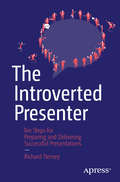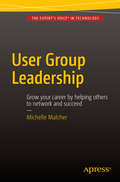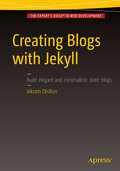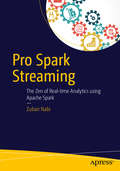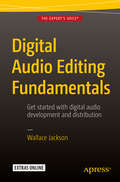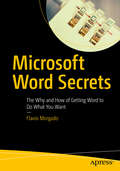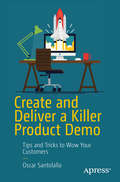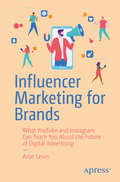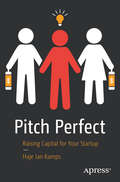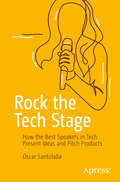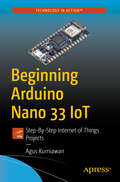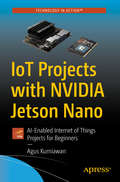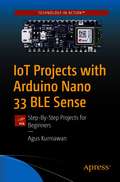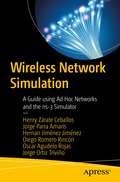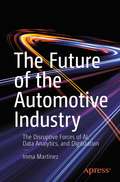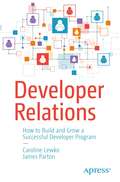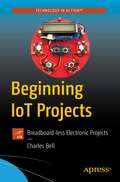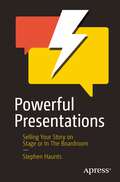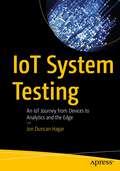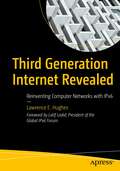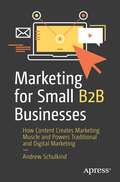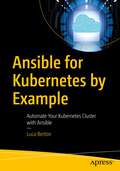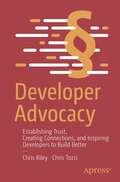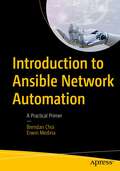- Table View
- List View
The Introverted Presenter
by Richard TierneyThe introvert is a personality type that draws energy from the outside inward. According to standard personality testing assessments, most people are introverts and no group is more introverted than technical professionals. Introverts are congenitally programmed to recoil from the prospect of public speaking with fear and loathing, yet making presentations to expert and non-expert audiences is an inescapable requirement for career advancement in any technical field. Presentation coach Richard Tierney rides to the rescue of fellow introverts in the IT and engineering sectors with The Introverted Presenter--his fail-safe guide to delivering competent presentations, no matter how unsuited by nature you might be to the performing arts. This short book lays out the complete process guaranteed to raise you from a debilitating state of terror and aversion to a comfortable place of clarity, calm, and competence--perhaps even brilliance, if you can train yourself to convert the free energy of your fear into controlled performance. Tierney repeatedly warns his introvert readers that they risk presentation fiasco if they skip, skimp, or change the order of any of the ten steps he prescribes for thoroughly and efficiently preparing their presentations. The surefire sequence of steps for The Introverted Presenter begins with defining your presentation''s audience and objective. The next step is to write the script of your speech in stages, constructing it on the basis of proven structural rules, cognitive laws, and dramatic tricks. Then you incrementally refine and tighten your script by delivering it iteratively, first in front of a mirror and then in front of increasingly critical test audiences, progressing from your cat to your boss. When you have a well-constructed and sound-tested script in hand and only then, you may create some slides to graft into your script in support of your opening action call and your concluding takeaways, which you commit to memory. Your slides should be limited to the smallest number possible (even zero) and the fewest possible words. What you''ll learn By following the process precisely as described in this book, even the most introverted technology professional will gradually but surely acquire the ability to Structure a killer presentation Coach yourself into being the best performer you can be Craft a presentation that supplies your audience''s technical needs while activating its human sympathies Use slides sparingly for best supporting effect Deploy elements of stagecraft like a trouper Who this book is for The primary readership is technology professionals who ordinarily shun the public-speaking limelight but find they need to pitch their work outside their team environments. The secondary readership is non-extroverts in the corporate, commercial, or academic worlds who have taken career promotions that involve presentations as part of their job descriptions. Table of Contents Chapter 1. Introverts and Presentations: Harnessing Terror Chapter 2. Face the Presentation Specter: Feared More Than Death Chapter 3. Find Your Presentation''s Focus: Ready, Steady Chapter 4. Impose Your Presentation''s Structure: Taking the Reins Chapter 5. Write Your Speech: Fear Returns Chapter 6. Refine Your Speech: Relishing the Panic Chapter 7. Try On Your Presenting Persona: Trotting the Course Chapter 8. Master Your Presentation Technology: Bending the Servant to Your Will Chapter 9. Chunk Your Presentation: Linking Primacy, Latency, and Failsafe Devices Chapter 10. Rehearse Your Presentation: Practice, Practice till Thoroughly Bored Chapter 11. Deliver Your Presentation: Treading the Hustings Like a Trouper Chapter 12. Encore! Rolling On to Your Next Presentation Chapter 13. Instant Clarity: Scaring Up an Emergency Presentation in One Day
User Group Leadership
by Michelle MalcherThis book is about starting and sustaining a technology user group. User groups are a wonderful way to connect with local and like-minded professionals for networking and learning. All the forums and social media on the internet can't replace face-to-face time spent discussing problems, upcoming technologies, and other pertinent topics. What every user group needs is leaders to organize meetings, find speakers, and connect the community. What every leader needs is good advice and guidance on how to begin a group and nurture new leadership to keep the group sustainable, and Michelle Malcher provides just that right sort of guidance in her book on User Group Leadership. This book is designed to help you understand what goes into starting and building a user group, giving you the tools and resources to do so. Learn what to expect before your first meeting, in the first three months, and in the first year. Malcher has experience from the local group level on up to the international level with the Independent Oracle User Group. If you're involved in technology and are ready to take on a position of leadership by which to help others network, succeed, and grow, then grab a copy of this book. You won't find a better source of guidance for starting and growing a new group on the technology of your choice. Learn what to know before you ever have your first meeting Prepare for each meeting with a list of things that should be done Grow your local members into future leaders What you'll learn Choose the right motivations for starting a group Build a governance structure and integrate with an umbrella group Locate and book interesting speakers Recruit help to share the administrative burden Grow the next generation of leadership Make a difference in people's careers by helping them grow and network and learn Who this book is for User Group Leadership is aimed at technology professionals interested in networking and learning with like-minded people in their same technology area. The book is especially aimed at the ambitious professional who is ready to step into a leadership role by creating a vibrant user community where no such community currently exists, but one is needed. Table of Contents 1. Development of a User Group 2. User Group Governance 3. Building Leaders and Volunteers 4. User Group Planning 5. User Group Members 6. Challenges 7. Career Development 8. From Techie to Leader 9. Qualities of a User Group Leader 10. Qualities of a User Group Volunteer
Creating Blogs with Jekyll
by Vikram DhillonLearn to create your own blog using the Jekyll static site generator. You'll start with a simple template, add new features to it, automate any maintenance, attach social sharing, and begin writing. By the end of Creating Blogs with Jekyll, you will be able to create custom blogs with Jekyll, update the content with ease, and reach out to your readers with minimal effort. Because you've built your blog yourself, you'll know exactly how each component works, and you won't be dependent on an admin panel to maintain it. Creating Blogs with Jekyll equips you with the knowledge to create an elegantly designed blog and scale it to capture more readers. Recapture the magic of writing by creating great content and use an easy workflow in Jekyll to maintain it for blogging. Do new things and write about them in style with Jekyll. Takes you through building a fully functional blog from scratch using Jekyll Provides a fun way to work on a side-project and integrate cutting edge web technologies Teaches you how to update and maintain your awesome blog Jekyll is a simple, secure and very low maintenance blog engine that converts naturally written content in markdown into a beautiful and minimal blog. It allows you to focus on content creation and expressing yourself instead of spending all your time updating the plugins and maintaining the database. Jekyll does not rely on a database as a backend so your blog will be far more secure and reliable than any traditional blogging engines such as WordPress. We live in a day and age where short attention spans make it very difficult to expose a reader to interesting content. What better way to capture a reader's attention and retain viewers by captivating them by your own unique style and taste? Jekyll allows the content to shine with minimal distractions and a greater focus on the content and easy sharing of the content. What you'll learn Choose a base theme appropriate for your style and development Integrate various web technologies that will work well together and enhance your blog Automate social sharing components and comments workflow Make adjustments to themes, views and styles of blog posts Update any of the modular components of the blog and integrate new technologies Implementing Jekyll and deploying static websites for future projects Who this book is for Creating Blogs with Jekyll is for the developer who is ready to move beyond the complexities of maintaining a content management system by creating their own unique blog in their own style. It's for the project manager tired of spending all their time editing their blog on the admin panel and updating the content management system. Creating Blogs with Jekyll is an excellent choice for new developers to start blogging because of the simplicity of Jekyll's theming layer and writing workflow. It's an excellent choice for the web developer wanting to build their blog from scratch and expand their knowledge of higher level web technologies.
Pro Spark Streaming
by Zubair NabiLearn the right cutting-edge skills and knowledge to leverage Spark Streaming to implement a wide array of real-time, streaming applications. This book walks you through end-to-end real-time application development using real-world applications, data, and code. Taking an application-first approach, each chapter introduces use cases from a specific industry and uses publicly available datasets from that domain to unravel the intricacies of production-grade design and implementation. The domains covered in the book include social media, the sharing economy, finance, online advertising, telecommunication, and IoT. In the last few years, Spark has become synonymous with big data processing. DStreams enhance the underlying Spark processing engine to support streaming analysis with a novel micro-batch processing model. Pro Spark Streaming by Zubair Nabi will enable you to become a specialist of latency sensitive applications by leveraging the key features of DStreams, micro-batch processing, and functional programming. To this end, the book includes ready-to-deploy examples and actual code. Pro Spark Streaming will act as the bible of Spark Streaming. What you'll learn Spark Streaming application development and best practices Low-level details of discretized streams The application and vitality of streaming analytics to a number of industries and domains Optimization of production-grade deployments of Spark Streaming via configuration recipes and instrumentation using Graphite, collectd, and Nagios Ingestion of data from disparate sources including MQTT, Flume, Kafka, Twitter, and a custom HTTP receiver Integration and coupling with HBase, Cassandra, and Redis Design patterns for side-effects and maintaining state across the Spark Streaming micro-batch model Real-time and scalable ETL using data frames, SparkSQL, Hive, and SparkR Streaming machine learning, predictive analytics, and recommendations Meshing batch processing with stream processing via the Lambda architecture Who this book is for The audience includes data scientists, big data experts, BI analysts, and data architects.
Digital Audio Editing Fundamentals
by Wallace JacksonThis concise book builds upon the foundational concepts of MIDI, synthesis, and sampled waveforms. It also covers key factors regarding the data footprint optimization work process, streaming versus captive digital audio new media assets, digital audio programming and publishing platforms, and why data footprint optimization is important for modern day new media content development and distribution. Digital Audio Editing Fundamentals is a new media mini-book covering concepts central to digital audio editing using the Audacity open source software package which also apply to all of the professional audio editing packages. The book gets more advanced as chapters progress, and covers key concepts for new media producers such as how to maximize audio quality and which digital audio new media formats are best for use with Kindle, Android Studio, Java, JavaFX, iOS, Blackberry, Tizen, Firefox OS, Chrome OS, Opera OS, Ubuntu Touch and HTML5. What you'll learn Industry terminology involved in digital audio editing, synthesis, sampling, analysis and processing The work process which comprises a fundamental digital audio editing, analysis, and effects pipeline The foundational audio waveform sampling concepts that are behind modern digital audio publishing How to install, and utilize, the professional, open source Audacity digital audio editing software Concepts behind digital audio sample resolution and sampling frequency and how to select settings How to select the best digital audio data codec and format for your digital audio content application How to go about data footprint optimization, to ascertain which audio formats give the best results Using digital audio assets in computer programming languages and content publishing platforms Who this book is for Primary Audience: Podcasters, Bloggers, Composers, Musicians, Sound Designers, Digital Signage Content Producers, e-Learning Content Creators. Secondary Audience: Website Developers, Android Developers, iOS Developers, Multimedia Producers, Rich Internet Application (RIA) Programmers, Game Designers, User Interface Designers, User Experience Designers, Teachers, Broadcasters, Digital Content Publishers. Table of Contents Chapter 1 The Foundation of Digital Audio: The Sound Wave Chapter 2 The History of Digital Audio: MIDI and Synthesis Chapter 3 The Reproduction of Digital Audio: Data Sampling Chapter 4 The Transmission of Digital Audio: Data Formats Chapter 5 The Cleanup of Digital Audio: Noise Removal Chapter 6 The Isolation of Digital Audio: Trimming Tools Chapter 7 The Manual Labor of Digital Audio: Sample Editing Chapter 8 The Algorithms of Digital Audio: Audio Processing Chapter 9 A Visualization of Digital Audio: Spectral Analysis Chapter 10 The Compositing of Digital Audio: Using Tracks Chapter 11 The Creation of Digital Audio: Tone Generation Chapter 12 The Data Footprint of Digital Audio: Compression Chapter 13 The Automation of Digital Audio: Programming Chapter 14 Publishing Digital Audio: Delivery Platforms
Microsoft Word Secrets
by Flavio MorgadoGet hints, useful tricks, and solutions to those annoying problems that plague users of Microsoft's ever-popular word processing software. This book goes beyond a how-to guide. You will understand where some of Word's odd behavior comes from, how underlying inheritance rules can affect your formatting, and how to understand and make use of the many hidden characters that Word uses to control the text. By the end of the book, you'll be able to fly through your Word processing without the usual headaches. What You'll Learn Understand why you should care about hidden characters, and how they can save you time and headaches Use templates effectively, and produce your own templates Employ fast desktop publishing techniques to produce a polished final document Generate a table of contents and index Fix those pesky tables forever! Who This Book Is For Everyone who uses Microsoft Word and has encountered difficulties and felt frustrated and slowed down
Create and Deliver a Killer Product Demo: Tips And Tricks To Wow Your Customers
by Oscar SantolallaCreate great product demos and sell more of your product with the strategies and inspiration in this book. Insightful interviews are presented with professionals who are giving killer product demos in several types of businesses today. The strategies taught in this book are based on the analysis of product demos that made history and brought millions to their companies (Apple, Intel, Microsoft, Tesla, and more).Every day thousands of companies give demos to sell their products. In pre-sales for enterprise software a bad demo can make your product look too complex to the point where decision makers won't buy it. In Software-as-a-Service (SaaS) you need to quickly convert signups into active and paying users. At a product launch event you want a perfect demo that is both persuasive and memorable. Remember Steve Jobs?What You'll LearnApply a simple step-by-step method to create effective product demonstrationsKnow the 5 steps to create a wow momentStudy the first exhaustive analysis of product demos that made history: Douglas Engelbart’s Mother of All Demos; Steve Job’s Macintosh, iPod, and iPhone; and many moreAvoid common mistakes and maximize your presence as a technical presenterAlign your demo with your sales process in enterprise software, Software-as-a-Service (SaaS), mobile apps, etc.Be aware of trends in technology for product demosWho This Book Is ForStartup entrepreneurs, sales engineers, executive or sales representatives, and other professionals
Influencer Marketing for Brands: What YouTube and Instagram Can Teach You About the Future of Digital Advertising
by Aron LevinIn the next few years, brands are on track to spend billions of dollars on influencer marketing. This form of marketing—currently utilized with great success on Instagram and YouTube—is not a short-lived fad, but a tectonic shift for the future of digital advertising. It's the way of the future, and the responsibility is on business leaders to keep up.Modern marketing professionals looking to adopt influencer marketing for their brands face equally modern challenges. Like finding the right talent, tracking and measuring results and quantifying how this new marketing opportunity aligns with the overall strategy. Influencer Marketing for Brands is the field guide for the digital age. After working with hundreds of brands from across the globe, author Aron Levin shares his insider knowledge gained from research, strategy, and hands-on experience from more than 10,000 successful collaborations with influencers on Instagram and YouTube. He provides you with valuable insights that help you eliminate guesswork and avoid common mistakes. More importantly, he shows you how to turn influencer marketing into a scalable and sustainable marketing channel. The digital media landscape grows more complicated by the hour, and influencer marketing is no exception. Influencer Marketing for Brands breaks down the art and science of influencer marketing and helps you synthesize, contextualize and transform this new way of creating and distributing content with powerful formulas, proven strategies, and real-world examples.What You Will LearnPlan effective influencer marketing campaigns using a simple 3-step formulaCreate top performing YouTube videos that drive website traffic, app installs and salesUnderstand what to pay for influencer marketing and how much you should invest if you're just starting out Who This Book is ForMarketing and agency professionals, influencers and content creators, marketing students, those who are looking for more effective forms of advertising and are generally interested in understanding the new and evolving digital media landscape.
Pitch Perfect: Raising Capital for Your Startup
by Haje Jan KampsYou have a home-run startup idea and a whip-smart team to execute it. Everything should be in place to kick-start your company and secure funding. However, there is one more step that can make or break the entire deal: the pitch. Founders everywhere struggle to nail the perfect pitch to garner VC backing, and this book is here to help.Pitch Perfect by Haje Jan Kamps expertly teaches you how to tell your startup’s story. To raise venture capital, it is absolutely crucial that your foundation is a story that is accessible, compelling, and succinct. Kamps uses his invaluable experiential knowledge to guide you through your presentation, from slide deck specifics to storytelling details to determining a fundamental philosophy for your business. In the process of creating and formulating a pitch deck and the story to go with it, founders often discover deep flaws in their business idea. Perhaps the market is non-existent. It could be that the “problem” isn’t worth solving. Maybe the idea is so simple that it would be too easy to copy. Maybe it’s already been done, or the team simply is not up to the job. Pitch Perfect has all of those bases covered so that you can excel.How do you convince an institutional investor to part with their money and fund your company? The small block of time you are given for a pitch holds your startup’s future in its grasp. Learn how to craft your startup story in a way that will get people to lean into your message with Pitch Perfect. Your dream is only one pitch away.
Rock the Tech Stage: How the Best Speakers in Tech Present Ideas and Pitch Products
by Oscar SantolallaThis book unveils ten secrets on how to masterfully speak in the technology arena. It is primarily based on stories from entrepreneurs, executives and engineers from technology companies that have shaped history: Steve Jobs, Tim Cook, Elon Musk, Jim Grubb (Cisco), Mikko Hyppönen (F-secure), Jane Chen (Embrace Innovations) and many more. Most of them have appeared on the stages of large conferences and events presenting their products and inventions. Today the technology arena is more dynamic and innovating than ever: mobile applications, cloud services, artificial intelligence, clean technologies, blockchain, etc.There are increasingly more spaces to share knowledge and promote products. Both aspects make speaking about technology harder than ever: how should you speak about your product or company in a way that your audience not only gets what you say but gets inspired enough to become followers?The ten practices presented in this book are: story, demo, metaphor, data visualization, passion, props, presentation hacks, interaction, staging, and memory. All core aspects that a technical person needs to rock the stage at conferences. What You Will LearnA wide range of skills which will help you make a solid and persuasive presentation or talkHow to craft compelling storiesHow to write better (blogs and copy) about technical products and eventsWho This Book is ForDevOps, developer evangelists, testers, architects, product managers, sales engineers, solution architects, CTOs, CEOs, startup founders, marketers
Beginning Arduino Nano 33 IoT: Step-By-Step Internet of Things Projects
by Agus KurniawanDevelop Internet of Things projects with Sketch to build your Arduino programs. This book is a quick reference guide to getting started with Nano 33 IoT, Arduino’s popular IoT board. You’ll learn how to access the Arduino I/O, understand the WiFi and BLE networks, and optimize your board by connecting it to the Arduino IoT Cloud. Arduino Nano 33 IoT is designed to build IoT solutions with supported WiFi and BLE networks. This board can be easily extend through I/O pins, sensors and actuators. Beginning Arduino Nano 33 IoT is the perfect solution for those interested in learning how to use the latest technology and project samples through a practical and content-driven approach. What You’ll LearnPrepare and set up Arduino Nano 33 IoT boardOperate Arduino Nano 33 IoT board hardware and softwareDevelop programs to access Arduino Nano 33 IoT board I/OBuild IoT programs with Arduino Nano 33 IoT boardWho This Book Is ForMakers, developers, students, and professional of all levels.
IoT Projects with NVIDIA Jetson Nano: AI-Enabled Internet of Things Projects for Beginners
by Agus KurniawanExplore the capabilities of the NVIDIA Jetson Nano, an IoT device designed to perform computations like a computer desktop. This book will show you how to build your first project and optimize your devices, programs, and daily activities with the AI computation abilities of the Jetson Nano. This board consists of CPU Quad-core ARM A57 @ 1.43 GHz and GPU 128-core Maxwell. With this hardware specification, the board can run multiple neural networks in parallel for complex AI applications. With the integrated sensor and actuators, this board enables stronger IoT solutions and provides more advanced capabilities.Discover how develop complex IoT projects with the Jetson Nano today.What You’ll LearnSet up NVIDIA Jetson Nano deviceBuild applications like image classification, object detection, segmentation, and speech processingUse the Jetson Nano to process daily computer activities such as browsing the internet, checking emails, or playing music and videosImplement machine learning computations into your projectsWho This Book Is ForMakers, developers, students, and professional of all levels who are new to the NVIDIA Jetson Nano technology.
IoT Projects with Arduino Nano 33 BLE Sense: Step-By-Step Projects for Beginners
by Agus KurniawanGet started with the extremely versatile and powerful Arduino Nano 33 BLE Sense, a smart device based on the nRF52840 from Nordic semiconductors. This book introduces you to developing with the device.You'll learn how to access Arduino I/O such as analog and digital I/O, serial communication, SPI and I2C. The book also covers how to access sensor devices on Arduino Nano 33 BLE Sense, how to interact with other external devices over BLE, and build embedded Artificial Intelligence applications.Arduino Nano 33 BLE Sense consists of multiple built-in sensors such as 9-axis inertial, humidity, temperature, barometric, microphone, gesture, proximity, light color and light intensity sensors. With this book, you'll see how this board supports the Bluetooth Low Energy (BLE) network, enabling interactions with other devices over the network.What You’ll LearnPrepare and set up Arduino Nano 33 BLE Sense boardOperate Arduino Nano 33 BLE Sense board hardware and softwareDevelop programs to access Arduino Nano 33 BLE Sense board I/OBuild IoT programs with Arduino Nano 33 BLE Sense boardWho This Book Is ForMakers, developers, students, and professionals at any level interested in developing with the Arduino Nano 33 BLE Sense board.
Wireless Network Simulation: A Guide using Ad Hoc Networks and the ns-3 Simulator
by Henry Zárate Ceballos Jorge Ernesto Parra Amaris Hernan Jiménez Jiménez Diego Alexis Romero Rincón Oscar Agudelo Rojas Jorge Eduardo Ortiz TriviñoLearn to run your own simulation by working with model analysis, mathematical background, simulation output data, and most importantly, a network simulator for wireless technology. This book introduces the best practices of simulator use, the techniques for analyzing simulations with artificial agents and the integration with other technologies such as Power Line Communications (PLC).Network simulation is a key technique used to test the future behavior of a network. It’s a vital development component for the development of 5G, IoT, wireless sensor networks, and many more. This book explains the scope and evolution of the technology that has led to the development of dynamic systems such as Internet of Things and fog computing. You'll focus on the ad hoc networks with stochastic behavior and dynamic nature, and the ns-3 simulator. These are useful open source tools for academics, researchers, students and engineers to deploy telecommunications experiments, proofs and new scenarios with a high degree of similarity with reality. You'll also benefit from a detailed explanation of the examples and the theoretical components needed to deploy wireless simulations or wired, if necessary.What You’ll LearnReview best practices of simulator usesUnderstand techniques for analyzing simulations with artificial agentsApply simulation techniques and experiment designProgram on ns-3 simulatorAnalyze simulation resultsCreate new modules or protocols for wired and wireless networksWho This Book Is ForUndergraduate and postgraduate students, researchers and professors interested in network simulations. This book also includes theoretical components about simulation, which are useful for those interested in discrete event simulation DES, general theory of simulation, wireless simulation and ns-3 simulator.
The Future of the Automotive Industry: The Disruptive Forces of AI, Data Analytics, and Digitization
by Inma MartínezNothing defined the 20th century more than the evolution of the car industry. The 2020 decade will see the automotive industry leap forward beyond simply moving people geographically toward a new purpose: to become a services industry. This book takes readers on a journey where cars will evolve towards becoming “computers on wheels."The automotive industry is one of the sectors most profoundly changed by digitalization and the 21st century energy needs. You'll explore the shifting paradigms and how cars today represent a new interpretation of what driving should be and what cars should offer. This book presents exciting case studies on how artificial intelligence (AI) and data analytics are used to design future cars, predict car efficiency, ensure safety and simulate engineering dynamics for its design, as well as a new arena for IoT and human data. It opens a window into the origins of cars becoming software-run machines, first to run internal diagnostics, and then to become machines connected to other external machines via Bluetooth, to finally the Internet via 5G.From transportation to solving people’s problems, The Future of the Automotive Industry is less about the technology itself, but more about the outcomes of technology in the future, and the transformative power it has over a much beloved item: cars.What You’ll LearnExplore smart cities and their evolution when it comes to traffic and vehiclesGain a new perspective on the future of cars and transportation based on how digital technologies will transform vehicles Examine how AI and IoT will create new contexts of interactions with drivers and passengers alikeReview concepts such as personalizing the driving experience and how this will take formSee how self-driving cars impact data mining of personal dataWho This Book Is ForAnyone with an interest in digital advancements in the automotive industry beyond the connected car.
Developer Relations: How to Build and Grow a Successful Developer Program
by Caroline Lewko James PartonIncreasingly, business leaders are either looking to start a new developer program at their company or looking to increase the impact of their existing DevRel program. In this context, software developers are finally recognized as legitimate decision makers in the technology buying process, regardless of the size of their organization. New companies are appearing with the sole purpose of making tools for developers, and even companies whose primary focus was elsewhere are waking up to the developer opportunity. Even as the need and demand for DevRel has grown, there are still re-occurring challenges for DevRel leaders. It is these challenges that this book addresses, covering all aspects of a DevRel program. It is an essential reference to professionalize the practice of developer relations by providing you with strategic, repeatable, and adoptable frameworks, processes, and tools, including developer segmentation and personas, and developer experience frameworks. In Developer Relations, you’ll find the answers to the following questions: How do we convince stakeholders to support a program?How do we go about creating a program?How do we make developers aware of our offer?How do we stand out from the crowd?How do we get developers to use our products?How do we ensure developers are successful using our products?How do we measure success?How do we maintain the support of our stakeholders? After reading this book you’ll have a clear definition of what developer relations is, the type of companies that engage in DevRel, and the scope and business models involved. What You Will Learn Discover what developer relations is and how it contributes to a company’s successLaunch a DevRel program Operate a successful program Measure the success of your programManage stakeholders Who This Book Is For Those interested in starting a new developer program or looking to increase the impact of their existing one. From executives to investors, from marketing professionals to engineers, all will find this book useful to realize the impact of developer relations.
Beginning IoT Projects: Breadboard-less Electronic Projects
by Charles BellExperiment with building IoT projects without the demanding time or patience required to learn about electronics. This book thoroughly introduces readers of all ages to the world of IoT devices and electronics without getting bogged down by the overly technical aspects or being tied to a specific platform. You'll learn IoT, Arduino, Raspberry Pi from the ground up using the Qwiic and Grove components systems. The book begins with a brief overview of IoT followed by primers for the two most popular platforms; Arduino and Raspberry Pi. There is also a short tutorial on programming each host; Arduino C-like sketches and Python scripts respectfully. Thus, the book also helps you get started with your choice of platform. Next, you’ll learn the basics for the Qwiic and Grove component systems.The rest of the book presents a number of projects organized into easy-to-follow chapters that details the goal for the project, the components used, a walk-through of the code, and a challenge section that provides suggestions on how to improve or augment the project. Projects are presented for both the Arduino and Raspberry Pi where possible making each project as versatile as possible.What You'll LearnWrite Arduino sketchesCreate Python scripts for the Raspberry PiBuild IoT projects with Arduino and Raspberry PiUse the Qwiic and Grove component systemsJoin the electronics and IoT hobby world with almost no experienceHost projects data in the cloud using ThingSpeakWho This Book Is ForThose interested in building or experimenting with IoT solutions but have little or no experience working with electronics. This includes those with little or no programming experience. A secondary target would include readers interested in teaching the basics of working with Arduino and Raspberry Pi to others.
Powerful Presentations: Selling Your Story on Stage or In The Boardroom
by Stephen HauntsUnlock your potential and understand how you can have an audience hanging on to your every word. Entrepreneurs and business professionals often have to pitch their products and projects to an audience - whether at a conference stage, meetup group, to VC firms or even at the office to their peers and leaders. Through this book, you will learn how to plan, rehearse, and deliver the perfect presentation for your needs. You'll review different presentation styles, how to craft and structure a talk and how to make it engaging for the audience. If you've ever wondered how you can be chosen to speak at a conference, this book will show you how and go in depth on how to craft a winning talk synopsis and proposal to stand out over the competition. You'll also examine many other details that go into giving a presentation such as face and hand gesturing, pre-performance rituals like visualization techniques, time management , addressing technical difficulties, preparing for question-and-answer sessions, gathering feedback, the differences between in person events and online talks/webinars and how to mold your presentation to the medium. Powerful Presentations will show you how to perfect your public speaking and presentation skills.What You'll LearnExplore the design and structure of presentations that retain an audience’s attentionPrepare for a talk, including rehearsal, but also failure contingency planning for things like projectors, Wi-Fi, demo failure, etc.Review all of the useful tools and services available to help you develop and deliver a great presentationWho This Book Is For Professionals who want to design and deliver talks in their chosen fields of expertise, whether that be a software developer or an entrepreneur.
IoT System Testing: An IoT Journey from Devices to Analytics and the Edge
by Jon Duncan HagarTo succeed, teams must assure the quality of IoT systems. The world of technology continually moves from one hot area to another; this book considers the next explosion—of IoT—from a quality testing viewpoint. You'll first gain an introduction to the Internet of Things (IoT), V&V, and testing. Next, you'll be walked through IoT test planning and strategy over the full life cycle, including the impact of data analytics and AI. You will then delve deeper into IoT security testing and various test techniques, patterns, and more. This is followed by a detailed study of IoT software test labs, architecture, environments and AI. There are many options for testing IoT qualities based on the criticality of the software and risks involved; each option has positives, negatives, as well as cost and schedule impacts. The book will guide start-up and experienced teams into these paths and help you to improve the testing and quality assessment of IoT systems. What You Will LearnUnderstand IoT software test architecture and planningMaster IoT security testing and test techniquesStudy IoT test lab automation and architecturesReview the need for IoT security, data analytics, AI, Neural Networks and dependability using testing and V&V Who This Book Is ForReaders with basic knowledge of software development who want to learn more about IoT testing and its intricacies, as well as companies moving into the domain of IoT, and even those already deep into the IoT domain will benefit from this book.
Third Generation Internet Revealed: Reinventing Computer Networks with IPv6
by Lawrence E. HughesThis book covers the inexorable exhaustion of the IPv4 address space, the interim fix to this based on Network Address Translation (NAT) and Private Addresses, and the differences between IPv4 and IPv6. It will help you understand the limitations and problems introduced by the use of NAT and introduce you to the far simpler network and software designs possible, using a larger, unified address space.IPv6, a mature and viable replacement for IPv4, is currently used by more than 36% of all global Internet traffic. Wireless telephone service providers in many countries have migrated their networks to IPv6 with great success. The elimination of NAT and Private Addresses has vastly simplified network design and implementation. Further, there are now enough public addresses allocated to accommodate all anticipated uses for the foreseeable future. Most networking products and software, especially open-source software, are already fully IPv6 compliant. Today, no business should purchase obsolete products that support only IPv4. The global IPv6 Forum estimates that there are millions of networking professionals still needing to learn the fundamentals of IPv6 technologies to move forward. This book is for them. With plans in place for a shutdown of IPv4 on global networks (“Sunset IPv4”) the time to learn is now. If you want a job in IT, especially network hardware or software, and you don’t know IPv6, you are already obsolete. What You Will Learn This book serves as a guide to all relevant Internet Engineering Task Force (IETF) standards Request for Comments (RFCs), organized by topic and discussed in plain language Understand how IPv6 makes viable technologies such as multicast (for efficient global audio/video streaming), IPsec VPNs (for better security), and simpler VoIP Take “edge computing” to the limit by eliminating intermediary servers made necessary by IPv4 NAT–for example, making connections directly from my node to yours Discover how organizations can introduce IPv6 into existing IPv4 networks (“Dual Stack”), and then eliminate the legacy IPv4 aspects going forward (“Pure IPv6”) for the mandates going into place now (for example, US DoD requirements to move all networks to Pure IPv6)Recognize that 5G networking (the Grand Convergence of conventional networks and wireless service) depends heavily on the advanced features IPv6 Who This Book Is ForNetworking professionals. Readers should have at least some familiarity with the precursor protocol (IPv4) and legacy TCP/IP based networks. Some knowledge of network models, such as DoD four-layer model or OSI 7-layer model, is helpful to understand where the Internet Protocol fits into the larger picture. For network software developers using the Sockets API (in UNIX, Windows, etc.), this book will help you to understand the extensions to that API needed to work with IPv6.
Marketing for Small B2B Businesses: How Content Creates Marketing Muscle and Powers Traditional and Digital Marketing
by Andrew SchulkindSmall business marketers don’t need to understand technical minutia of websites or the high-level social media strategies of national consumer brands. They need to understand how to build successful marketing machines that they can sustain with the resources they have available. This book will help small-business B2B marketers build a strong digital presence that will drive growth. Most B2B buyers are about two-thirds of the way through their purchase process before they are willing to engage with a salesperson. Therefore, having a strong digital presence is the difference between making your prospect’s short list and your prospect not even knowing you exist. Most critically, a strong digital presence relies on content written from your audience’s perspective. This book provides insight and information about the questions that are critical to their business and that you can help them solve. It is the key to capturing their attention, gaining their trust, and winning their business. Marketing can’t work its magic alone. It needs the support of strong branding and must provide support to well-executed sales processes. Marketing for Small B2B Businesses will dive into the relationship between each of these areas. What You'll LearnBuild a website that serves as the hub of your marketingEstablish a content promotion plan that puts your content in front of the right audienceDevelop strategies and tactical plans for finding the channels best suited to your message such as social media and email marketing Create effective content in a timely manner with the resources you have availableTrack what is working and what needs improvement via an analytics platform to consistently produce strong marketing returnsWho This Book Is ForThe primary audience is B2B small business owners and B2B small business marketing leaders.
Ansible for Kubernetes by Example: Automate Your Kubernetes Cluster with Ansible
by Luca BertonLearn how to automate your Kubernetes infrastructure using Ansible. This book will enable you to automate more tasks and save time with this human-readable platform. Containerized microservices deployed via Kubernetes allows you to save time, reduce human interaction and errors, and create applications that are more robust. You’ll learn how to automate the most redundant activities such as reports, services, the launch of a pod, adding permanent storage, configuring load balancing, and adding or modifying any Kubernetes parameter. You'll also gain an understanding of end-to-end use cases and how advanced cluster automation, such as Helm packages and node states, are evolving. Each lesson utilizes a specific use-case for the modern Kubernetes cluster and focuses on a single module from the most crucial parameter, complete with code demonstrations. Each code example is battle-proven in real-life with console interaction and verification.What You'll LearnAutomate Kubernetes cluster management, cloud services, pods, and storage with AnsibleConfigure your Ansible controller nodeWrite and execute Ansible Playbook code that follows best practicesAugment your productivity by applying Infrastructure as Code (IaC)Troubleshoot Ansible Who This Book Is ForIT professionals who would like a jargon-free understanding of Ansible technology, Windows Systems Administrators, DevOps professionals, thought leaders, and infrastructure-as-code enthusiasts.
Developer Advocacy: Establishing Trust, Creating Connections, and Inspiring Developers to Build Better
by Chris Riley Chris TozziNo matter which point you're currently at on the developer advocacy journey – whether you've already implemented a developer advocate function or you're exploring the possibility – this book is for you. This book provides actionable guidance that business and technology leaders can use to understand the benefits of advocacy, identify what goes into the function, and learn how to maximize the success of developer advocate teams.Developer advocacy is a role that is sometimes hard to quantify and build – but you feel it when you’re missing it. Companies are struggling to solidify advocacy despite a strong desire to do so and little guidance exists for businesses seeking to build a developer advocacy program or assess its effectiveness. This book will show you how to get an advocacy program in your business: the basics of having an advocacy program, what tasks and processes need to be set up, and how to identify key stakeholders. You'll see how companies of all types that sell to or engage with technical audiences can develop a developer advocacy strategy. Specifically, you'll learn what developer advocates do, how business can start an advocacy practice in your organization and how to scale and operationalize such a practice once it is in place. The book will further explore the metrics for measuring advocacy success and ways the scale advocacy teams internally and externally. The Power of Developer Advocacy explores the exciting career path of advocacy for developers and engineers. What You Will LearnDiscover what developer advocacy isDetermine which sorts of companies need the functionUnderstand what the primary strategic considerations for developer advocacy isWho This Book is For Existing and future advocacy leaders, would-be developer advocates, developer marketers and DevRel teams and leaders
Introduction to Ansible Network Automation: A Practical Primer
by Brendan Choi Erwin MedinaThis book provides a comprehensive learning journey aimed at helping you master Ansible and efficiently automate a range of enterprise network devices, such as routers, switches, firewalls, Wireless LAN Controller (WLC), and Linux servers. Introduction to Ansible Network Automation combines the fundamentals of three books into one, covering basics of Linux administration, Ansible concepts, and Ansible network automation. Authors Brendan Choi and Erwin Medina have created a structured learning path that starts with the fundamentals and allows you to progressively enhance your skill sets with each chapter. Part I serves as an Ansible primer, guiding you through Linux basics using WSL on Windows 11 and assisting in the setup of your learning environment. Part II covers essential Ansible concepts through practical lab activities involving four Linux servers. In Part III, you will learn how to apply your Linux skills from Part I and the concepts from Part II to real-world scenarios by creating Ansible automation YAML scripts. What sets this book apart is its unique focus on Ansible and Network Automation, combined with a strong emphasis on understanding Linux. It is specifically designed for novice network automation engineers and students, assuming no prior Linux expertise, and provides first-hand experience starting from scratch. It also offers practical insights by sharing real-life examples of Ansible playbooks derived from production enterprise infrastructure, allowing you to gain an understanding of how Ansible can be effectively applied in real-world enterprise network environments. Upon completion of this book, you will have developed foundational skills in Ansible network automation and general Linux administration, and will understand how to apply this newly acquired knowledge to real-life scenarios. What You Will Learn Develop a comprehensive understanding of Ansible and its essential concepts for automating enterprise network devices and applying them to real-world scenariosMaster the basics of Ansible operations within Linux automation and progress to applying Ansible concepts specifically to network device automationExecute Ansible ad-hoc commands and playbooks for a range of network operational tasks, including configuration management, software and system updates, and upgradesWork with real-life examples of Ansible playbooks derived from actual enterprise infrastructure, gaining practical experience in writing Ansible YAML scriptsAcquire the skills to automate network operations using Ansible, streamline network management processes, and replace manual-driven tasks with directives in Ansible playbooks Who is This Book For Network, security, UC and systems engineers, as well as technical leaders, IT managers and network students.
Natural Disaster: I Cover them. I am one.
by Ginger ZeeGinger grew up in small-town Michigan where she developed an obsession with weather as a young girl. Ginger opens up about her lifelong battle with crippling depression, her romances that range from misguided to dangerous, and her tumultuous professional path.
